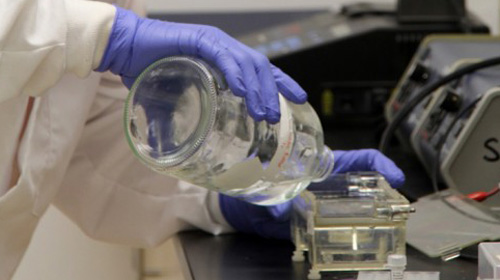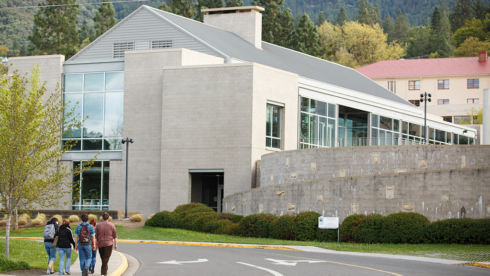
ABOUT THIS SERIES: This story is part of a series in collaboration with the Ashland Daily Tidings spotlighting the work, research and experiments taking place in laboratories on the Southern Oregon University campus. During the year, these invention centers and their specialized equipment are only accessible to university students, faculty and staff. But on May 15, dozens of departmental labs and art studios will be open to the public during the fifth annual Southern Oregon Arts and Research open house. For more information about SOAR activities, performances and presentations, call 541-552-6816 or visit www.sou.edu/soar.
“This is probably the most important piece of equipment in the lab,” says David Oline, gesturing toward a nondescript gray box, slightly larger than a mini-fridge, resting on a counter.
The box houses an Applied Biosystems ABI310 Capillary DNA sequencer, a 10-year-old device that Oline and others in Southern Oregon University’s Biotechnology Center use to analyze a multitude of entities, from fir trees to Alphaproteobacteria.
Although the DNA sequencer is small and somewhat out-of-date compared to the equipment found at large research universities, it’s a good fit for the experiments at SOU, Oline says.
“For our facility and our purposes, this is a nice unit to have,” says Oline, an associate professor of biology at SOU and lab manager of the newly renovated Biotechnology Center. “This is probably one of the most up-to-date labs on campus. We try to take as much advantage of it as we can.”
The Police’s “Message in a Bottle” blares from a small speaker on a shelf, nestled among a forest of pipets and vials, as Oline drifts around the room in his white lab coat, tidying up and offering advice to students such as Sheiy-Anne Sargento.
As Sargento prepares a set of DNA samples for the sequencer, Oline shows her how to work the vacuum centrifuge and input sample data into the computer. Sargento’s capstone project is analyzing the hybridization between red fir and noble fir.
Oline explains that most of the hands-on work that SOU students do in the lab doesn’t happen at larger universities.
“At typical research universities, you slip your sample in the slot in the door and you get an email a couple days later saying your results are on the server,” he says. “At a research university, they’ve got slicker labs than we do, but the focus isn’t on the students, it’s on getting the research done.”
There are several process steps to prepare a DNA sample for the sequencer, Oline explains. First, the raw sample is broken down chemically, often using a commercial DNeasy kit that extracts and purifies just the DNA. Then the extract is used in a polymerase chain reaction process that amplifies only a single gene of interest, replicating enough material to work with in subsequent procedures.
The amplified DNA is then run through a cleanup process that attaches fluorescent markers to the gene sequence to filter out excess reaction components and materials, allowing the sequencer equipment to “read” the sample DNA sequence.
The sample is run through another cleanup process, which purifies the sample even more. The DNA is dried out in a vacuum centrifuge and then rehydrated with a formamide solution. The DNA samples are labeled and loaded into the sequencer, which analyzes the fluorescent markers to build a model of the DNA sequence.
Finally, the genetic sequence is displayed on a computer screen and researchers can compare these data against the codes found in GenBank, a free, public, worldwide bank of sequence information maintained by the National Center for Biotechnology Information.
Although knowing the process is important, Oline says, the fun part comes after the results show up on the computer.
The process “just generates data,” he says. “Interpreting it is what you want to do.”
For the past six years, Oline and several of his students have been analyzing the differences between red and noble fir trees, trying to find the genetic border between the two species. Several students, including Sargento, are contributing to the massive experiment as part of their capstone project.
Noble fir grows primarily in the north, from Oregon into Canada, and red fir grows primarily in the south, from Southern Oregon to California. Southern Oregon is a “hybridization zone,” where the two species intermingle. Telling them apart has given botanists headaches for years, so Oline and his team have been trying to find the genetic line between the two.
“I’m really kind of proud of the red fir project,” he says. “It’s nothing really earth-shattering, but it’s standard (reading) in our undergrad classes.”
Oline explains that it is unusual for non-research universities to have facilities such as this and allow undergraduates to work in them.
“We have a very slick facility,” he says. “This is probably one of the nicest labs on campus.”
For more photos please visit: http://www.facebook.com/media/set/?set=a.337262362990974.93005.136698886380657&type=1&l=b20011aa1c



